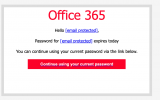thecomputerguy
Well-Known Member
- Reaction score
- 1,412
A while back I made a post here: https://www.technibble.com/forums/t...dard-office-365-spam-filtering-product.85921/
Asking for a spam filtering product for O365 because I have several problem clients who love to use me as a human spam filter and it really irritates me.
The general consensus was that the built in tools for spam in O365 are plenty "fine" but you just need to adjust them properly.
What do you all do to adjust the O365 tenant to make them filter spam properly if it were just starting as a brand new O365 tenant.
I have clients who are getting multiple emails a week that look like this garbage and they just forward them to me and say "Hey! is this spam?" I want to reply and say "Hey! Are you dumb?" but I usually just answer with a yes.

Asking for a spam filtering product for O365 because I have several problem clients who love to use me as a human spam filter and it really irritates me.
The general consensus was that the built in tools for spam in O365 are plenty "fine" but you just need to adjust them properly.
What do you all do to adjust the O365 tenant to make them filter spam properly if it were just starting as a brand new O365 tenant.
I have clients who are getting multiple emails a week that look like this garbage and they just forward them to me and say "Hey! is this spam?" I want to reply and say "Hey! Are you dumb?" but I usually just answer with a yes.

